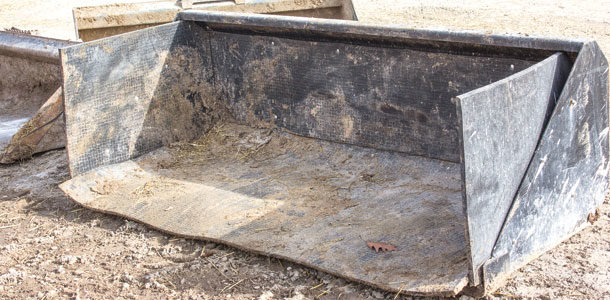Down cows are a fact of life for any dairy owner. Although down cow incidents may be reduced through high-quality care and good facilities, they will never be fully eliminated. To deal with this issue, Gordon and Cathy Speirs, the owners of Shiloh Dairy in Brillion, Wisconsin, have not only laid out set protocols for their employees to follow, but they have a rubber-lined bucket dedicated to the task.
Altogether, the dairy houses around 4,400 head, about 2,000 of which are milking cows. The rest are dry cows, replacement heifers and calves. While the Speirs only moved from Alberta, Canada, to their present location a little more than 11 years ago, they have been in the dairy industry for much longer.
Gordon and Cathy are fourth-generation dairy farmers, and their sons Travis and Tyler, who work full-time on the dairy, are the fifth. Dairy farming is in their blood, and caring for their cattle to the best of their ability is at the top of their list of priorities.
With the recent rise in public concern over certain issues, one of which is down cows, they decided it was time for a farm meeting and an evaluation of their own practices.
The main change they made was to designate a bucket specifically for moving down cows. This bucket would be lined with heavy-duty rubber to give the cow added comfort and eliminate any pinch points. While the bucket itself was Gordon’s idea, Travis has been the one to use it since he oversees the care of down cows on the farm. They’ve had the bucket for about a year now, and he has been quite happy with the results so far.
“We wanted to make sure we had one that was big enough for the cow and didn’t have any pinch points,” Travis says. “We had one specially made so we can roll her back nice and far so there’s no chance of her falling out. Then we lined it with rubber just to get rid of any of the pinch points and make it a little more comfortable ride for her.”
Because the bucket is free of pinch points and clean, they will often not have any scuff marks from being in the bucket. Travis says sometimes he will arrive in the morning and have to ask why the cow has been moved to the straw pack.
He also adds that lining the bucket with rubber not only helps with cow comfort, but it also prevents the bucket from being used for anything else on the farm. Before, the bucket would sometimes be used for other tasks on the dairy and would often have manure or something else in it when they needed it. Now there is always a clean, readily available bucket for down cows.
At the meeting, they also wrote down the protocol for moving a down cow. Although this remained the same as before, they felt this was important to do to ensure it is done correctly every time. According to Travis, the importance of following protocol is stressed to their employees as the right way to move a down cow and the only way that is good for her.
Cathy says that while they have talked about doing a training session for their employees where they could practice how to move a down cow, they decided against it. Down cows are not a situation that can be created, and giving a cow an anesthetic so they could practice moving her did not seem the most humane.
However, as Cathy points out, they have hired cattlemen to help them run their dairy. They should have been trained and know how to halter a cow, tie her head to her back leg and move her safely into the bucket. If they do not choose to follow the established protocols, then their employees are in the wrong business and they’ve hired the wrong people.
At least half of the employees are knowledgeable on how to move a down cow and could instruct others if necessary. During the day, the herd manager is in charge of handling down cows. At night, it is the calving pen manager’s job to handle the transport of the down cow.
They are also responsible for her treatment. If an emergency arises, they call Travis, who only lives a few minutes from the dairy. He will then assess the situation and decide if a vet needs to be called.
In the past year, Travis says they have also tightened their window for how long they will allow a cow to be down before they euthanize her. If the cow has not stood up in the first 24 to 36 hours, they end her suffering, and often they make the call closer to the 24-hour mark.
The odds of her standing up on day three or four are slim to none, so they make sure to do the right thing for her early on. Cathy explains that if she’s down for very long, several other concerns may arise.
“Experience has taught us that after a day or more, they usually don’t stand up,” Cathy says. “They’re such big heavy animals that you get a lot of muscle atrophy and nerve damage when they’re lying down, so the longer they’re down, the longer they’re going to be down, and then at some point they are physically unable to stand up again. Then it becomes an issue of animal abuse to leave them down just suffering.”
Although Cathy says she cannot remember the last time they had a down cow, preparing to have one is part of owning a dairy regardless of the size of the operation. Producers need to plan for them and make sure they are taken care of properly.
“We try not to have down cows,” Cathy says. “But whether you have one cow or a million cows, you’re going to have down cows. Cows go down. That’s what they do from time to time, so we get them to safety if where they are is not safe or in their best interests.” PD
PHOTO
Shiloh Dairy in Brillion, Wisconsin, made an extra-large, rubber-lined bucket to transport down cows. The bucket’s additional size and rubber reduce pinch points for the cow and give her a more comfortable ride while traveling to a straw-bedded recovery pen on the dairy. Photo by Jenna Hurty.

Jenna Hurty
Editor
Progressive Dairyman
Shiloh Dairy’sdown cow protocols
1. Make sure the alley is clean behind her.
2. Position her so she is sitting up properly.
3. Halter her and tie her head to her back leg so she is in a curled-up position.
4. Bring the bucket up just beside her, roll her away from the bucket and slide the bucket underneath her.
5. Have two people roll her into the bucket as it is slowly tipped up. She should end up lying on her side.
6. Take her to the calving pen and put her on a straw bed.*
* An owner, the herdsman or the calving pen manager will then treat her.






